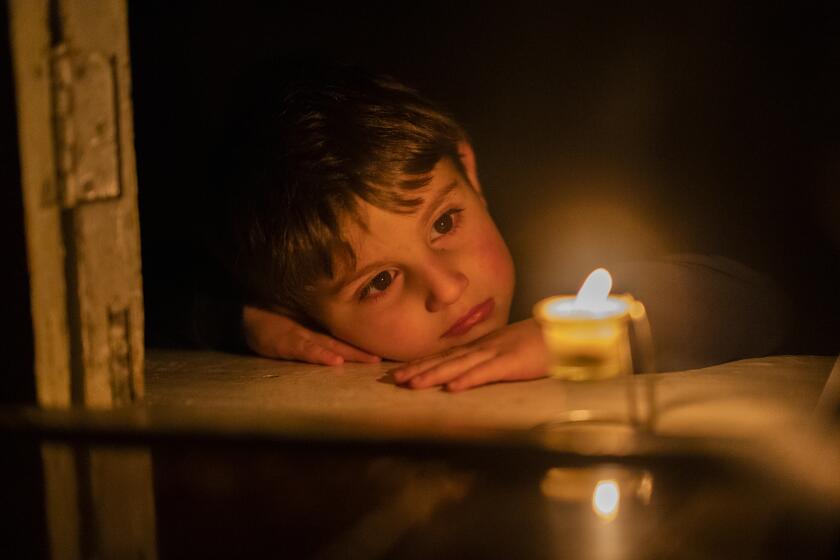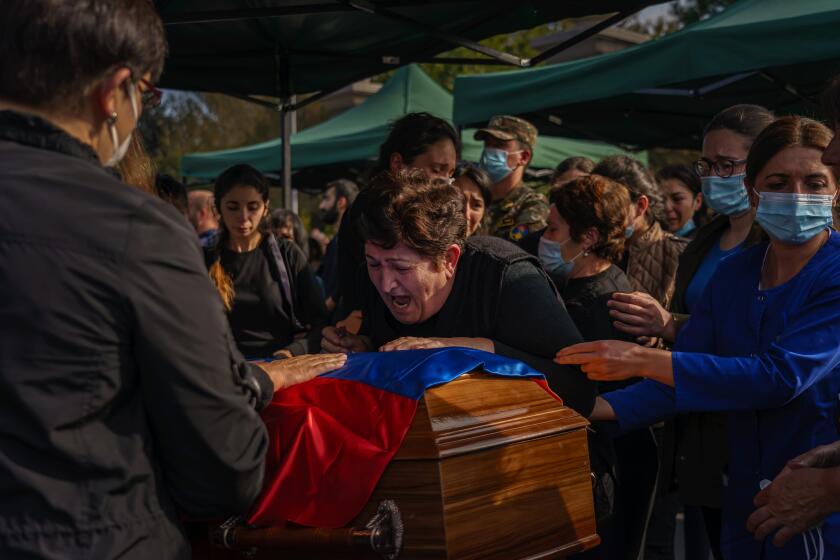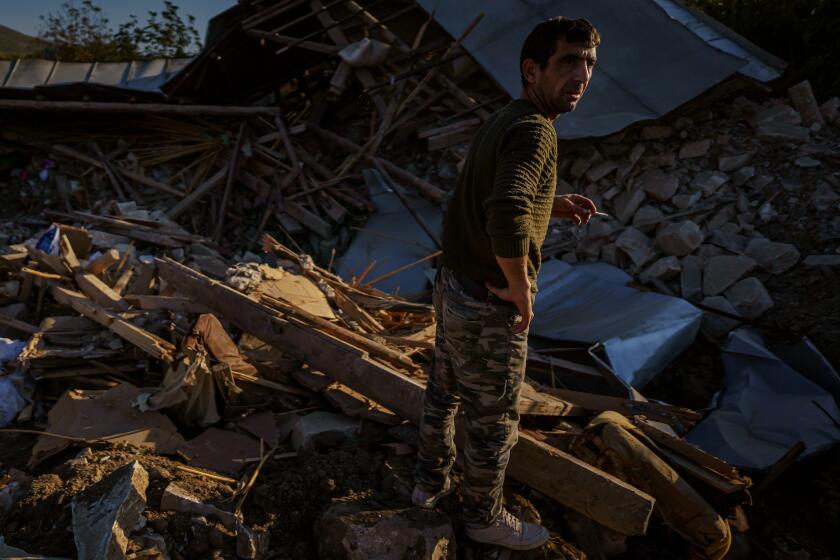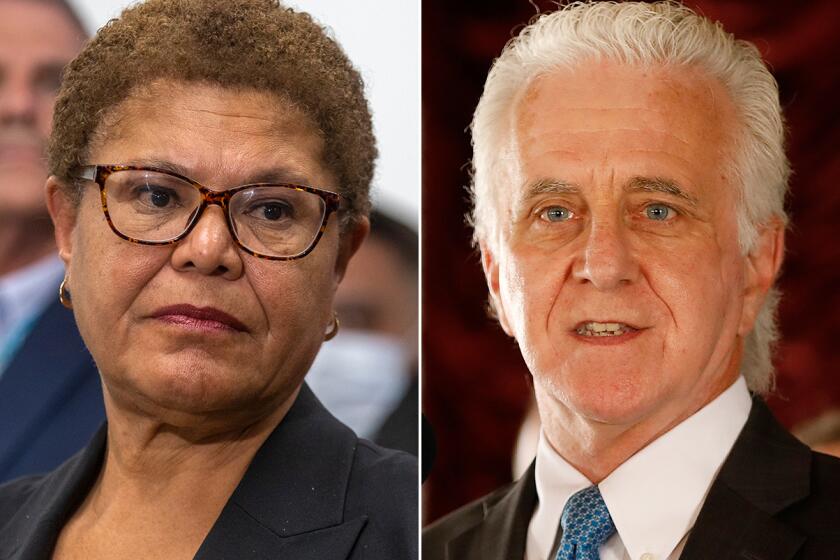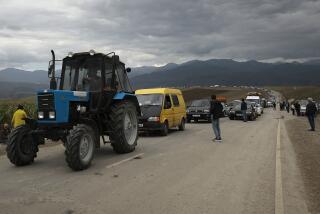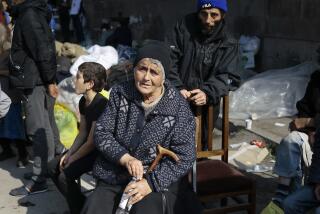‘Staying, for us, is impossible.’ Thousands of ethnic Armenians flee Nagorno-Karabakh
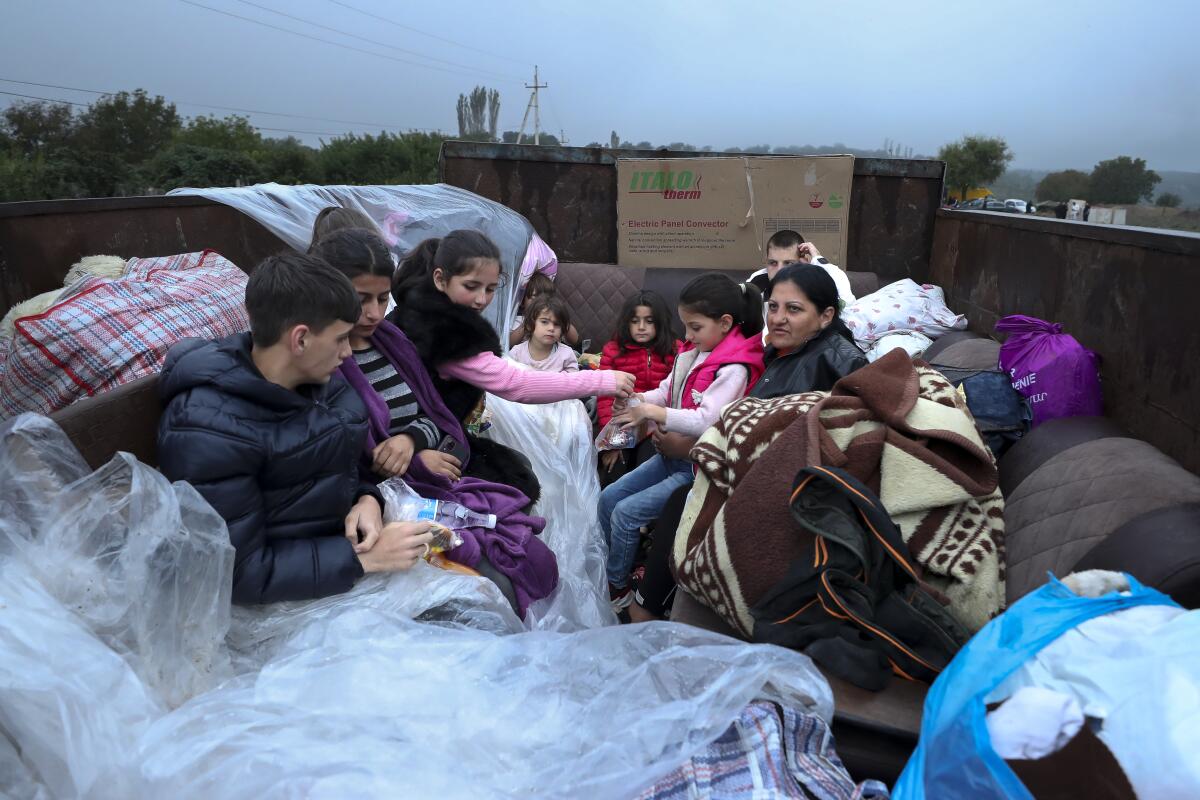
- Share via
BEIRUT — The exodus began late Sunday, a trickle of vehicles that soon turned into an unceasing stream flowing along the mountain highway above Nagorno-Karabakh toward the Armenian border.
By Monday, almost a week after the Azerbaijani military took back Nagorno-Karabakh in a 24-hour blitz, more than 6,650 ethnic Armenians had left the enclave and crossed into Armenia, the Armenian government said. Many more are expected to follow, in a mass migration that is almost certain to transform the character of a territory internationally recognized as part of Azerbaijan but long inhabited mostly by people pledging allegiance to Armenia.
In the city of Stepanakert, the region’s capital (Azerbaijan calls it Khankendi), there were tear-filled farewells as people took leave of their homes and engaged in the somber calculus of what to salvage and what to leave behind.
“Staying, for us, is impossible. Living under Azerbaijani and Turkish authority, we can’t do it. We can’t live with them, can’t live under their rule,” said Hovik Asmaryan, referring to the prospect of Azerbaijani control — with the backing of ally Turkey — of Nagorno-Karabakh, which Armenians call Artsakh.

A Syrian Armenian who left Syria in 2012 because of the war there, Asmaryan had settled in Stepanakert, set up a farm and opened up a restaurant. Now he was waiting for a break in the congestion on the highway to Armenia before he, too, made his exit.
“The restaurant and its equipment, the farm — we’ve left them as they are. My car is too small to take things with me. I can barely fit my wife and children in it,” Asmaryan said.
Tensions between Armenia and Azerbaijan are high again two years after they ended a war over Nagorno-Karabakh that killed about 6,800 soldiers.
“Everything we built over the years, everything we saved, all of it is going to stay,” he added, before sighing and repeating: “All of it is going to stay.”
Pro-Armenia secessionists had controlled Nagorno-Karabakh and its seven surrounding districts, which together cover an area 1½ times the size of Delaware, since the end of a yearslong war in 1994 that saw some 30,000 people killed and more than 1 million people — the majority of them Azeri — displaced. Though the territory remained legally under Azerbaijan, separatists set up an Armenia-backed breakaway government and standing army.
A 44-day flare-up of hostilities in 2020 saw Azerbaijan claw back those districts and parts of Nagorno-Karabakh, including the strategic Lachin Corridor, the enclave’s only road link to Armenia. In December, Azerbaijan blocked Lachin, essentially besieging Nagorno-Karabakh and causing food and fuel shortages, despite the presence of Russian peacekeeping troops.

Last week, after Azerbaijan announced that six people had been killed because of mines planted by pro-Armenian forces, the Azerbaijani military launched an offensive to consolidate its control over the region, shrugging off the Russian peacekeepers. The lightning operation soon forced a capitulation from the breakaway government, but not before some 200 people were killed and 400 wounded.
The campaign also touched off fears of a pogrom among the territory’s roughly 120,000 ethnic Armenians (Azerbaijani observers claim the real number is closer to a quarter of that), despite assurances from President Ilham Aliyev that “the Armenian population of Karabakh are our citizens” and that his government’s reintegration efforts would turn the enclave into a “paradise” for all its residents.
On Monday, at a news conference alongside Turkish President Recep Tayyip Erdogan, Aliyev said: “It is crystal clear that, independent of their ethnicity, the people living in the Karabakh region are Azerbaijani people, so their safety and security is ensured by the Azerbaijani state.”
Azerbaijani officials have discussed an amnesty for those who lay down arms and accept the authority of Baku, the Azerbaijani capital, though it’s unclear whether that would cover those alleged to have committed atrocities during the 2020 fighting or the earlier war.
Their decades-old battle over the mountainous territory of Nagorno-Karabakh has come to define how Armenians and Azerbaijanis view themselves.
Since its quick victory, Azerbaijan has reopened the Lachin Corridor for those who want to leave Nagorno-Karabakh and allowed aid convoys to enter. On Sunday, it linked Stepanakert to Azerbaijan’s national power grid and restored electricity.
“It demonstrates that our intentions of reintegrating these people and meeting their basic demands are serious,” said Esmira Jafarova, a former Azerbaijani diplomat and board member of the Baku-based Center of Analysis of International Relations.
Those moves, however, don’t really change the situation, Armenian Prime Minister Nikol Pashinyan said in a televised address Sunday.
“If real conditions for Nagorno-Karabakh Armenians to live in their homes and effective mechanisms of protection from ethnic cleansing are not created, the chances that the Nagorno-Karabakh will see leaving their homeland as the only way to save their lives and identity is greatly increased,” he said, adding that Armenia was prepared to welcome Armenians who flee.
Start your day right
Sign up for Essential California for the L.A. Times biggest news, features and recommendations in your inbox six days a week.
You may occasionally receive promotional content from the Los Angeles Times.
Pashinyan’s address came as protesters gathered for their daily protests in Yerevan, the Armenian capital, against his government and what many see as his appeasement before Azerbaijani threats. Demonstrations continued Monday.
For many, the demise of what separatists called the Artsakh Republic, one of a constellation of self-proclaimed republics created after the Soviet Union’s collapse, has geopolitical significance far beyond Nagorno-Karabakh. That Moscow did not come to the aid of Armenia, a longtime ally, they say, is a measure of how little a Ukraine-obsessed Russia is able now to steer affairs in what was once its sphere of influence.
For Armenia, aligning with Russia has proved to be the wrong choice, Pashinyan said in his Sunday address.

“The attacks on Armenia carried out by Azerbaijan in recent years allow us to draw an obvious conclusion that the external security structures in which we participate are ineffective from the point of view of the state interests and security of Armenia,” Pashinyan said. He added that events in Nagorno-Karabakh raised “serious questions” about the goals and motives of Russia’s peacekeepers.
Pashinyan’s broadside was the latest in a series of moves signaling Armenia’s shift away from Moscow and toward Washington. Earlier this month, U.S. and Armenian troops conducted a joint military exercise, and Pashinyan’s wife visited Ukrainian President Volodymyr Zelensky in the Ukrainian capital, Kyiv.
Those overtures did not go unnoticed by Moscow. In his speech at the United Nations General Assembly last week, Russian Foreign Minister Sergei Lavrov described the flare-up in Nagorno-Karabakh as the work of a powerful lobby of Western-linked nongovernmental organizations seeking to undermine Russian influence.
Armenia and Azerbaijan enlist artists, lobbyists and online activists in a 21st century propaganda war in their fight over Nagorno-Karabakh.
“We know who is interested in this and who is leading it,” Lavrov said. “We are strongly convinced that the Armenian people remember our common history and connect their history with Russia and other friendly countries — first and foremost, the countries in this region, rather than those overseas.”
At the same time, however, the defeat of the breakaway forces in Nagorno-Karabakh neutralizes a long-running problem that could have given Western powers an opening to encroach on Moscow’s backyard, Russian politician Maxim Shevchenko told the newspaper Pravda on Saturday.
“The Karabakh problem ... brought the United States and the European Union to the Caucasus,” Shevchenko said. “Now they have no reason to get into it. They are now sitting gnashing their teeth.”
Shevchenko also suggested that Armenia’s small population, relative lack of natural resources and few transnational links make it a less attractive ally when compared with Azerbaijan’s riches and potential markets.
The use of drones has upset the military balance between Azerbaijan and Armenia in their longtime dispute over the territory of Nagorno-Karabakh.
For all its crowing over last week’s military triumph, Azerbaijan faces challenges reintegrating Nagorno-Karabakh. Hundreds of thousands of Azeris, many of them descended from those displaced decades ago, hope to move to the region. Some 5,000 Azeris have already returned to some of the areas recaptured in the 2020 war, including the town of Shusha (which Armenians call Shushi) and surrounding areas, with plans to resettle more than 100,000 people by 2026, said Zaur Shiriyev, a Baku-based Caucasus analyst with the International Crisis Group.
Although Azerbaijan has embarked on a reconstruction drive, said Jafarova of the Center of Analysis of International Relations, it will take some time before the area can handle resettlement.
“People do want to go back, but there’s landmine clearance, which is a huge security threat,” she said, adding that government estimates expect de-mining operations to cost $25 billion and take three decades.
On Monday, Azerbaijani negotiators met with separatists in the town of Khojaly to hash out a political settlement.
The Los Angeles area is home to the largest concentration of Armenians outside of Armenia, a diaspora with deep roots in the city.
The pro-Armenia government in Nagorno-Karabakh released a statement assuring residents that it would continue to work until all those who wanted to move to Armenia could do so. It also asked public officials, healthcare professionals and law enforcement agencies to continue their professional duties.
It called on residents to postpone immediate travel plans to allow the transportation of wounded and displaced people, and said it would provide free fuel to those leaving starting Monday afternoon.
On Monday night, an explosion rocked a gas station near Stepanakert as residents waited to fill up their cars to leave. The blast killed 20 people and wounded nearly 300, scores of them in grave condition, authorities said Tuesday. It was not immediately clear what caused the blast.
Earlier, Gev Iskajyan, a member of the Armenian National Committee of America and director of the Armenian National Committee of Artsakh, which operates in Stepanakert, predicted that the majority of Nagorno-Karabakh’s residents would be unwilling to take their chances under rule from Baku and would “be gone by the end of the week.”
“Looking back to Azerbaijan’s history, I don’t know how in any way authorities can guarantee the safety and the rights of the ethnic Armenian populace,” he said, taking a break from coordinating departures out of Stepanakert.
“The problem isn’t electricity or aid; it’s living under a regime that wants to subjugate you, a regime that cannot show a single Armenian community that exists within its territory. You’re asking people to play Russian roulette with their lives.”
The Associated Press contributed to this report.
More to Read
Sign up for Essential California
The most important California stories and recommendations in your inbox every morning.
You may occasionally receive promotional content from the Los Angeles Times.
